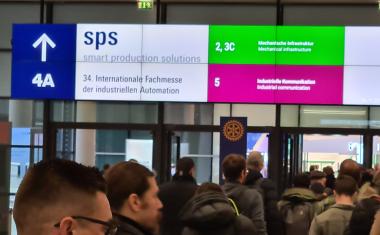Optics - Infrastructure for Light
Inspect talked about technologies and technical developments in industrial image processing and for measuring and testing methods to Nicholas D. James, Imaging Product Line Manager, from Edmund Optics' North American headquarters.
Industrial testing and development laboratories now depend upon image processing and optical measuring systems to ensure and maintain modern high-quality production. The unique requirements of these applications rely on ready availability of an immense number of optical components and systems. That's why global manufacturer and supplier of optics and imaging components, Edmund Optics (EO), stocks more than 26,500 products for immediate delivery.
inspect: The current Edmund Optics catalog has almost 500 pages with a total of ten product categories. Which of these categories are of particular interest to users in the field of industrial image processing?
N. D. James: The Edmund Optics catalog covers a portfolio of about 26,500 products which is continually updated to reflect the needs of our customers and the markets. Most of our products meet Machine Vision needs, but the ones most focused on that space are Imaging Optics, Cameras, Illumination, Targets and sometimes even Microscopy for the high magnification objectives, an area where also optical components such as filters are commonly used.
inspect: Stated very simply, illumination, optics, sensors, processing and data output are the main components of an image processing system. First of all, let us take a look at illumination. To what extent has LED technology revolutionized these applications?
N. D. James: LED technology allows users to select discrete wavelengths of light while maximizing their intensity. Traditionally users would select their desired wavelength by filtering a broadband light source such as a halogen lamp. Unfortunately, that approach discards most of the source intensity. Wavelength selection with today's LED technology is much easier. Edmund Optics allows customers to take advantage of these new capabilities with LED products such as LED fiber optic illuminators. In fact, Edmund Optics is seeing more and more customers switching from halogen to LED-based sources, including large LED backlights, which are easier to produce and offer a more uniform illumination at a lower cost.
inspect: Optics can also be considered to be the only image processing systems which can operate in real time. What can optical systems now achieve, which was not possible ten years ago? How have they changed?
N. D. James: Optics have become far more critical over the last decade due to the advent of higher resolution sensors with smaller pixel sizes. The resolution of imaging systems used to be far more limited by the camera sensor; now we see more and more that systems are being limited by the choice of optics. Today's imaging optics and camera sensors need to be selected together, as the choice of lens often drives system performance. For example, optics designed for the long working distances of security applications will not provide high enough levels of performance on today's sensors at typical "machine vision" working distances (<2,000mm). You have to turn to optics that are optimized in your specific application space, e.g. TECHSPEC® Compact Fixed Focal Length Lenses offered by EO. Lens manufacturers should provide more than just a part. Each optic should come with a modulation transfer curve (MTF curve) at the required desired working distance, wavelength range, and f/# setting, so that the different application specific options can be compared. Optics have become much more critical in today's systems - they determine the overall system quality. If the optic is not right, the performance of the entire system suffers.
inspect: 3D image processing is the technology of the future. Which technical solutions and products cater for this development?
N. D. James: 3D imaging is certainly a growing area in the inspection market. It's slowly carving out a place because so many applications can benefit from it. Many of the optical components used for standard 2D imaging work very well for 3D imaging as well. Most of the same products can be used in dual camera and lens setups, or setups with one system and a laser line for scanning. Depending upon the specific system requirements, the need of the respective application could be met with anything from small, low-cost micro video lenses to high-resolution fixed focal length lenses. There are advances in software that ease adoption. As algorithms get faster and user interfaces get better, it's easier for more people to implement 3D systems.
inspect: The fact that image processing technology is being increasingly incorporated into automated production is not new. However, the dynamics of this process have increased. What are the changes for the components of a system if measuring and testing are to be incorporated into production lines?
N. D. James: As more and more markets start to embrace machine vision and inspection technologies, the costs are pushing even lower for basic setups, allowing for even more markets to have access to the technology. The optical components are the same, but the sensor and LED innovations continue to drive costs down while maintaining or even improving performance. In many companies, one of the largest hurdles remains the lack of internal imaging system expertise. But even that is becoming easier to overcome as courses, videos, whitepapers, and technical support from manufacturers become prevalent, comprehensive, and accessible.
inspect: Image processing systems and optical measuring systems have long-since left the field of laboratories and factories. They are now used in agriculture; they fly over our people's heads in drones, or form an integral part of intelligent traffic control systems and infrastructures. Can this still be done with standard components, or can you offer special products for these applications?
N. D. James: Often standard components are still preferred over custom solutions. Existing standard products cover a very broad application space, and new products are always being added to the standard lines. Standard products meet the needs of most applications. The imaging system attached to a road inspection truck typically uses the same type of lens and camera as a beverage bottle inspection system in a factory. Although custom optics are always an option, we find most customers usually find an optimum solution among our range of standard components.
inspect: The ability to see, intelligence and mobility are three characteristics which an autonomous robot must have. What would need to be available for these applications in a future Edmund Optics catalog under the category "Robotics"?
N. D. James: As exciting as it would sound to have a Robotics category, Edmund Optics believes that it is still in the future. Robotics still requires significant efforts in programming and development, along with upfront cost. Robotics as a category is not quite suited for selling in a catalog. As the industry heads toward plug and play and costs are driven down through volume increases and technological jumps, more customers will be willing to purchase the technology through a catalog. Of course, many of our standard components can easily meet the requirements for robotics and automation, and we'll continue to support system developers working in those fields.









